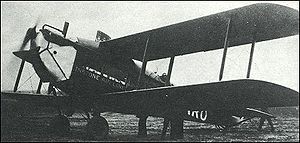De Havilland DH.18 Video -
|
|
De Havilland DH.18
DH.18

Role: Airliner
Manufacturer: Airco
Designed by: Geoffrey de Havilland
First flight: 1920
Introduced: 1920
Retired: 1923
Primaryusers: Aircraft Transport and Travel
Daimler Hire Ltd
Instone Air Line
Produced: 1919-1921
Number built: 6
The de Havilland DH.18 was a single engined British biplane transport aircraft of the 1920s built by de Havilland.
Design and development
The DH.18 was designed and built in 1919 by Airco as their first aircraft specifically for commercial work, earlier aircraft such as the DH.16 being modified military types. The DH.18 was a single engined biplane, powered by a Napier Lion engine with wooden two bay, wire braced wings, and a forward fuselage clad in plywood. It accommodated eight passengers in an enclosed cabin with the pilot in an open cockpit behind the cabin. The first prototype flew early in 1920.
Operational history
The first DH.18 was delivered to Aircraft Transport and Travel for use on the Croydon-Paris service, but was wrecked in a forced landing shortly after takeoff from Croydon on 16 August 1920. Two more aircraft were under construction by Airco for Aircraft Transport and Travel when the bankrupt Airco was purchased by BSA, who did not wish to continue aircraft development or production. Geoffrey de Havilland, the chief designer of Airco then set up the de Havilland Aircraft Company, completing the two partly completed aircraft as DH.18As, with improved engine mountings and undercarriages.
Aircraft Transport and Travel closed down in early 1921, due to competition from subsidised French airlines. In March 1921, the British government granted temporary subsidies for airline services, with the Air Council purchasing a number of modern commercial aircraft for leasing to approved firms. The three ex-A.T.&T. DH.18s were purchased in this way and leased to Instone Air Line. A further DH.18A was built to Air Council order, as were two modified DH.18B, which had fuselages that were entirely plywood clad and had built in emergency exits.
The DH.18s were kept busy flying on continental air services for Instone, building up high flying hours. One aircraft, G-EAWO, was transferred to Daimler Airway for operation on the Croydon-Paris route until the de Havilland DH.34s which it had on order could be delivered. However, on 4 April 1922, two days after Daimler commenced operations with the aircraft, it collided with a Farman Goliath over Northern France, 62mi (100km) north of Paris, killing seven people, the first mid-air collision between airliners.
The DH.18 was retired from commercial service in 1923, with one aircraft, G-EARO, having flown 90,000mi (144,834km) without accident. Two aircraft were used for test purposes, with one the subject of an Air Ministry experiment on how long an aircraft could stay afloat after being ditched, being deliberately landed on water off Felixstowe on 2 May 1924, floating for 25 minutes. The other remaining aircraft was used for test purposes at RAE Farnborough until 1927, when it was scrapped.
Variants
DH.18 Prototype - registered G-EARI. DH.18A Initial production version - modified undercarriages and engine mountings. Three built - (G-EARO, G-EAUF, G-EAWO). DH.18B Plywood covered fuselage and increased weights. Two built - (G-EAWW and G-EAWX).
Operators
United Kingdom
Aircraft Transport and Travel
Instone Air Line
Daimler Hire Ltd
Handley Page Transport
Specifications (DH.18A)
Data from British Civil Aircraft since 1919, Volume 2
General characteristics
Crew: One (pilot)
Capacity: Eight passengers
Length: 39 ft 0 in (11.89 m)
Wingspan: 51 ft 3 in (15.62 m)
Height: 13 ft 0 in (3.96 m)
Wing area: 621 ft² (57.7 m²)
Empty weight: 4,040 lb (1,833 kg)
Loaded weight: 6,515 lb (2,956 kg)
Powerplant: 1x— Napier Lion 12-cylinder water-cooled W-block aircraft piston engine, 450 hp (336 kW)
Performance
Maximum speed: 109 kn (125 mph, 201 km/h)
Cruise speed: 87 kn (100 mph, 161 km/h)
Range: 348 nmi (400 mi, 644 km)
Service ceiling: 16,000 ft (4,900 m)
Rate of climb: 660 ft/min (3.4 m/s)
Wing loading: 10.5 lb/ft² (51.2 kg/m²)
Power/mass: 0.069 hp/lb (0.11 kW/kg)
Related development
De Havilland DH.16
De Havilland DH.34
De Havilland DH.54
Comparable aircraft
Vickers Vulcan
BAT FK.26
Westland Limousine
Bristol Ten-seater "10 seater"
Martinsyde F6 "Buzzard"
Sopwith Antelope
Sopwith Wallaby
Living Warbirds: The best warbirds DVD series.
Source: WikiPedia